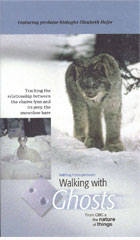
Walking with Ghosts 2004
Distributed by Bullfrog Films, PO Box 149, Oley, PA 19547; 800-543-FROG (3764)
Produced by CBC’s The Nature of Things
Directed by Caroline Underwood
VHS , color, 45 min.
Jr. High - Adult
Animal Behavior, Environmental Studies
Date Entered: 10/10/2005
Reviewed by Cliff Glaviano, Coordinator of Cataloging, Bowling Green State University Libraries, Bowling Green, OHThis video documentary follows predator biologist Elizabeth Hofer as she tracks lynx in the boreal forests in and around the Kluane National Park in Canada’s Yukon Territory. The experience of tracking lynx has been equated with “walking with ghosts.” Hofer studies the relationship between the lynx and its preferred prey, the snowshoe hare. Lynx populations closely follow the population cycle of the snowshoe hare which experiences a dramatic decline every ten years to levels equal to about 1% of its peak population density. In peak years, Hofer calculates that the hare population comprises the greatest biomass of the boreal forest. To survive, a lynx must consume the equivalent of one hare per day. Hofer’s work indicates that lynx predation drives the variation in hare population cycle by placing female snowshoe hares under constant stress as peak lynx populations prey on peak hare populations: stress enough to impact on the hares’ reproductive success.
Technically, the video production standards measure well up to CBC’s continually high levels of excellence. The camerawork credited to Ron Shade is superlative, capturing the lynx in its winter environs, along with its chief prey, the snowshoe hare, and such secondary prey as red squirrels and voles. The camera work detailing Hofer’s tracking is carefully planned to emphasize the solitary nature of her work and her isolation in the winter forest. There’s an awful lot of careful, hard work in evidence in this production. Walking with Ghosts is recommended for its excellent treatment of predator/prey relationships and for providing the viewer with glimpses into the solitary existence of the elusive lynx as it fights to survive the sub-Arctic winter.
This video will enhance library collections in ecology, natural history, and zoology. It shows the best of deep winter in the wilds of western Canada, cloudless skies, the sparkling windless, snowless days when the sun raises the temperature to within a few degrees above or below zero Fahrenheit. The life of one called to field wildlife biology is clearly not an easy one, though the rewards of solitary existence, the gaining an understanding of how humans, lynx, and their prey all have a common heritage in wilderness surely may be of great individual value. As the lynx depends on the snowshoe hare, we depend directly or indirectly on our environment. Who knows, even in times of apparent abundance, when our consumption of those resources may endanger the survival of our species?